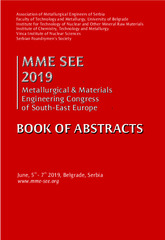Приказ основних података о документу
Quartz sand processing methods for the application in water glass production
| dc.contributor | Glišić, Dragomir | |
| dc.contributor | Marković, Branislav | |
| dc.contributor | Manojlović, Vaso | |
| dc.creator | Mihajlović, Slavica | |
| dc.creator | Sekulić, Živko | |
| dc.creator | Blagojev, Marina | |
| dc.creator | Kašić, Vladan | |
| dc.date.accessioned | 2023-08-15T08:08:53Z | |
| dc.date.available | 2023-08-15T08:08:53Z | |
| dc.date.issued | 2019 | |
| dc.identifier.isbn | 978-86-87183-30-8 | |
| dc.identifier.uri | https://ritnms.itnms.ac.rs/handle/123456789/668 | |
| dc.description.abstract | To use quartz sand for water glass production, processing of raw quartz sand is necessary. The objectives of processing are: achieving the required granulometric composition, increasing the content of SiO2 and reducing the content of impurities that lower its quality. The most frequently used method is the attrition cleaning in combination with gravity and magnetic concentration. In order to eliminate quartz sand impurities to a greater extent, it is approached to different methods of preparing mineral raw materials, which depends of the content and type of impurities as well as on the way they appear (as individual grains, surface coatings on quartz grains or as a form of intergrowth with quartz). The size reduction processes are used when it comes to sandstone or large-grained sand, whereby the size decreases up to 0.6 mm. Besides that, washing, attrition scrubbing, grading and also gravity, flotation, and magnetic concentration are used. Desliming, washing, and grading procedures are used almost always because there is clay present in the quartz raw material as impurities. The scrubbing procedure in attrition machines is used when the quartz surface is kaolinized and limonitised. The flotation concentration is used when in raw material beside the quartz, there is mica and feldspar, with preceding washing and grading procedures to eliminate the clay component. That is so-called „reverse“ flotation consisting of flotating mica and feldspar is applied, and the pure quartz remains in the pulp. The magnetic separation process is used when in quartz raw material are also magnetic impurities type Fe2O3 as carriers of total iron. Efficacy of the removal of iron is expressed as a rate of reduction of Fe2O3. In the company „Kesogradnja d.o.o.“ at Kozluk, near Zvornik (Republic of Srpska) from quartz sand deposit „Bijela Stijena Skočić“, quartz sand for the production of water glass was obtained by the procedures of washing, grinding, sizing and magnetic separation. | sr |
| dc.language.iso | en | sr |
| dc.publisher | Belgrade : Association of Metallurgical Engineers of Serbia | sr |
| dc.relation | info:eu-repo/grantAgreement/MESTD/Technological Development (TD or TR)/34013/RS// | sr |
| dc.rights | openAccess | sr |
| dc.source | 4th Metallurgical & Materials Engineering Congress of South-East Europe 2019 - MMESEE 2019 | sr |
| dc.subject | quartz sand | sr |
| dc.subject | separation | sr |
| dc.subject | magnetic separation | sr |
| dc.subject | water glass | sr |
| dc.title | Quartz sand processing methods for the application in water glass production | sr |
| dc.type | conferenceObject | sr |
| dc.rights.license | ARR | sr |
| dc.citation.epage | 49 | |
| dc.citation.spage | 49 | |
| dc.identifier.fulltext | http://ritnms.itnms.ac.rs/bitstream/id/1173/bitstream_1173.pdf | |
| dc.type.version | publishedVersion | sr |

